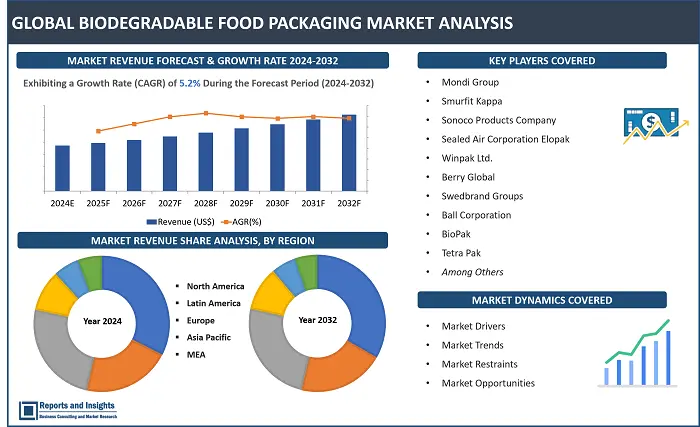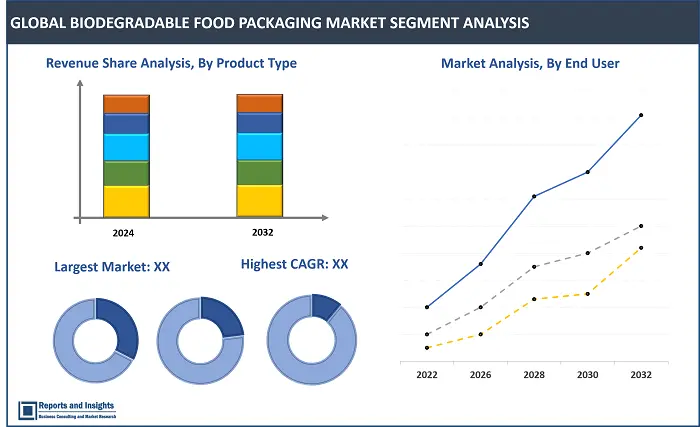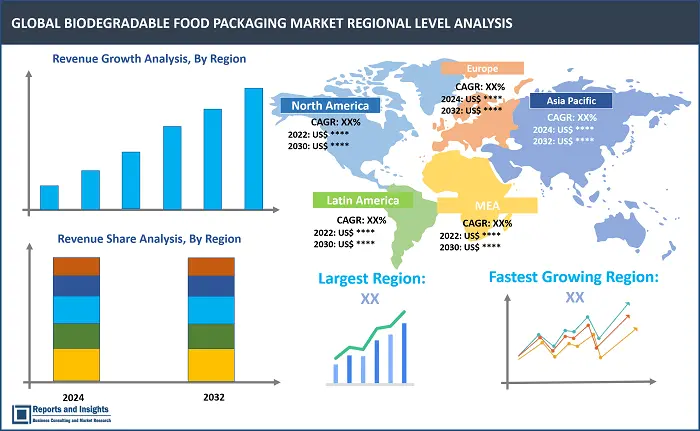Market Overview:
"The biodegradable food packaging market size reached US$ 220.3 billion in 2023. Looking forward, Reports and Insights expects the market to reach US$ 347.7 billion by 2032, exhibiting a growth rate (CAGR) of 5.2% during 2024-2032."
|
Report Attributes |
Details |
|
Base Year |
2023 |
|
Forecast Years |
2024-2032 |
|
Historical Years |
2021-2023 |
|
Market Growth Rate (2024-2032) |
5.2% |
Biodegradable food packaging is packaging that can break down naturally in the environment, usually without leaving harmful residues. It decomposes through biological processes, such as microbial action, into simpler, non-toxic compounds that can be reabsorbed into the ecosystem. This type of packaging is designed to reduce the environmental impact of packaging waste and is a more sustainable option compared to traditional non-biodegradable materials.
The market for biodegradable food packaging is witnessing notable growth, propelled by rising consumer awareness and demand for sustainable packaging solutions. In response to the imperative to reduce plastic waste and environmental impact, biodegradable food packaging presents itself as an environmentally friendly substitute for traditional packaging materials. Market participants are actively engaged in innovating with new biodegradable materials, such as compostable plastics, bio-based polymers, and plant-based fibers, to cater to this growing demand. Furthermore, governmental regulations and initiatives advocating for sustainable practices are further fueling the market's expansion. Consequently, the biodegradable food packaging market is poised for sustained growth as more businesses and consumers prioritize sustainability.

Biodegradable Food Packaging Market Trends and Drivers:
The biodegradable food packaging market is primarily fueled by rising environmental concerns regarding conventional plastic packaging, which has led to a surge in demand for sustainable alternatives. Government regulations advocating for the use of biodegradable materials, the transition toward a circular economy, and consumer preferences for eco-friendly products are also key drivers. Additionally, technological advancements in biodegradable materials and manufacturing processes, along with corporate sustainability initiatives and intensifying market competition, are contributing significantly to the market's expansion and innovation.
Biodegradable Food Packaging Restraining Factors:
The biodegradable food packaging market faces several constraints that impede its growth. One major challenge is the higher cost associated with biodegradable packaging materials compared to traditional plastic options, which can discourage widespread adoption, especially in cost-sensitive markets. Limited awareness and understanding of biodegradable packaging among consumers and businesses also hinder market expansion. Additionally, the performance and shelf life of some biodegradable materials may not yet match those of traditional plastics, limiting their use in certain applications. Regulatory uncertainties and inconsistencies in standards for biodegradability and compostability further complicate the market landscape. Overcoming these challenges will be essential for the broader acceptance and adoption of biodegradable food packaging solutions.
Biodegradable Food Packaging Market Opportunities:
The biodegradable food packaging market presents lucrative opportunities for expansion and innovation. With a rising consumer awareness and demand for sustainable packaging, there is a growing necessity for biodegradable alternatives to conventional plastic packaging. This scenario creates a conducive environment for companies to develop and introduce new biodegradable materials and packaging formats. Additionally, with governments worldwide implementing regulations to curb plastic waste, there is a burgeoning market for biodegradable packaging solutions that comply with these mandates. Furthermore, the surge in e-commerce and food delivery services has generated a demand for sustainable packaging solutions that are both eco-friendly and convenient for on-the-go consumption. In essence, the biodegradable food packaging market is positioned for substantial growth as businesses and consumers increasingly prioritize sustainability.
Biodegradable Food Packaging Market Segmentation:

By Packaging Format
- Films and Containers
- Bottles
- Cups
- Bags
- Boxes
- Others
The packaging format segment is further divided based on films and containers, bottles, cups, bags, and others. The boxes and bags segment captured the highest revenue share and is expected to maintain its dominance over other packaging format segments throughout the forecast period. With the increasing trend of ordered food consumption, the use of boxes becomes essential, providing a practical solution to accommodate and protect ready-to-eat food items. Boxes offer more space for packaging compared to bags, making them a preferred choice for secondary packaging needs. This preference for boxes in the packaging of ordered and ready-to-eat food products is a key driver of market growth.
By Material
- Paper & Paperboard
- Plastic
- Metal
- Glass
- Others
The material segment is further subdivided based on paper & paperboard, plastic, metal, glass, and others. The paper & paperboard segment dominates the highest revenue share and is projected to continue its dominance over other material segments throughout the forecast period. Paper and paperboard materials are the most commonly used packaging materials in the food and beverage industry due to rising environmental concerns. Ready-to-eat, fresh, and frozen meals are increasingly offered in paperboard packaging.
By Application
- Meat
- Fish
- Dairy Products
- Bakery Confectionary
- Fruits and Vegetables
- Others
The application segment is further subdivided based on meat, fish, dairy products, bakery confectionery, fruits and vegetables, and others. The ready-to-eat segment secured the highest revenue share and is expected to maintain its dominance over other application segments throughout the forecast period. Ready-to-eat food packaging is dominant in the market as consumers prefer packed and prepared food products that are ready for consumption without any further cooking or preparation. This segment includes packaging solutions for a wide range of food items such as fruits, snacks, vegetables, meat products, and ready meals.
By Region

North America
- United States
- Canada
Europe
- Germany
- United Kingdom
- France
- Italy
- Spain
- Russia
- Poland
- Benelux
- Nordic
- Rest of Europe
Asia Pacific
- China
- Japan
- India
- South Korea
- ASEAN
- Australia & New Zealand
- Rest of Asia Pacific
Latin America
- Brazil
- Mexico
- Argentina
Middle East & Africa
- Saudi Arabia
- South Africa
- United Arab Emirates
- Israel
- Rest of MEA
The global biodegradable food packaging market is segmented into five key regions: North America, Europe, Asia Pacific, Latin America, and the Middle East and Africa. Europe represents mature markets primarily due to the population's higher concern for eco-friendly and sustainable packaging in the region. North America is the fastest-growing region in the biodegradable food packaging market due to the higher demand for ready-to-eat and packed food products.
Leading Biodegradable Food Packaging Manufacturers & Competitive Landscape:
The biodegradable food packaging market is highly competitive, with numerous key players competing for market share through strategic initiatives. These companies prioritize product innovation, technological advancements, and expanding their product portfolios to gain a competitive edge. They continuously invest in research and development to improve their products and meet the evolving needs of customers in terms of efficiency, performance, and sustainability.
These companies include:
- Mondi Group
- Smurfit Kappa
- Sonoco Products Company
- Sealed Air Corporation Elopak
- Winpak Ltd.
- Berry Global
- Swedbrand Groups
- Ball Corporation
- BioPak
- Tetra Pak
- Melodea
- Crown Holdings Inc.
- BASF
- Huhtamaki Oyj
- Cascades
- Westrock
- Evergreen packaging
Biodegradable Food Packaging Market Recent News and Development
- January 2024: Berlin Packaging has announced its acquisition of Alpack Limited, a family-owned food packaging supplier based in Dublin, Ireland.
- January 2024: Sealed Air Corporation launched compostable protein packaging tray at IPPE 2024
- March 2024: Eco-Products has expanded its GreenStripe line of compostable products by introducing a range of paper bags, sandwich wraps, and other items.
- October 2023: Danimer Scientific, Inc, has unveiled the launch of home compostable retail packaging designed for vegetables and fruits. This innovative packaging was developed in collaboration with BIOLO, a manufacturer of biodegradable packaging and food service products, and Bolthouse Farms, a carrot producer.
- March 2023: JALUX Inc. announced that they had chosen to use KANEKA Biodegradable Polymer Green Planet as the packaging material for onigiri (rice ball) served at the JAL Diamond Premier Lounge at Haneda Airport.
- August 2023: Amcor announced that it has reached an agreement to acquire Phoenix Flexibles. This acquisition will enhance Amcor's capacity in the rapidly growing Indian market.
- July 2023: Melodea launched MelOx NGеn, a cellulose-based food packaging solution with a water-based, plant-sourced coating. This coating is designed to line the inside surface of packaging such as films, pouches, bags, lidding, and blister packs used for consumer packaged goods (CPG) products. It aims to enable the recyclability of plastic food packaging while maintaining food freshness and reducing plastic waste sustainably.
- July 2023: BioPak UK introduced an eco-friendly food packaging range made from FSC-certified paperboard or industrially compostable materials. The new range includes a 4oz ice cream tub with two different-sized lids, a chip box with a chip scoop, a medium-sized sushi tray with a matching lid, as well as wrap wedges and sandwich wedges.
- January 2023: Cascades introduced a new closed basket made from recycled and recyclable corrugated cardboard for the produce sector. This new product, an alternative to food packaging that is challenging to recycle, is the newest addition to Cascades' range of environmentally friendly packaging solutions.
- October 2023: Pakka Limited, previously known as Yash Pakka Limited, a manufacturer specializing in compostable packaging solutions, has launched India's first compostable flexible packaging.
Biodegradable Food Packaging Market Research Scope
|
Report Metric |
Report Details |
|
Market size available for the years |
2021-2023 |
|
Base Year |
2023 |
|
Forecast Period |
2024-2032 |
|
Compound Annual Growth Rate (CAGR) |
5.2% |
|
Segment covered |
Packaging format, material, application and regions. |
|
Regions Covered |
North America: The U.S. & Canada Latin America: Brazil, Mexico, Argentina, & Rest of Latin America Asia Pacific: China, India, Japan, Australia & New Zealand, ASEAN, & Rest of Asia Pacific Europe: Germany, The U.K., France, Spain, Italy, Russia, Poland, BENELUX, NORDIC, & Rest of Europe The Middle East & Africa: Saudi Arabia, United Arab Emirates, South Africa, Egypt, Israel, and Rest of MEA |
|
Fastest Growing Country in Europe |
Germany |
|
Largest Market |
North America |
|
Key Players |
Mondi Group, Smurfit Kappa, Sonoco Products Company, Sealed Air Corporation Elopak, BioPak, Winpak Ltd., Berry Global, Cascades, Swedbrand Groups, Ball Corporation, Tetra Pak, Crown Holdings Inc., BASF, BioPak, Huhtamaki Oyj, Westrock, Evergreen packaging. |
Frequently Asked Question
At what CAGR will the biodegradable food packaging market expand?
The market is anticipated to rise at 5.2% through 2032.
What are some key factors driving revenue growth of the biodegradable food packaging market?
Some key factors driving biodegradable food packaging market revenue growth include innovative food packaging material, importance on sustainability and others.
What are some major challenges faced by companies in the biodegradable food packaging market?
Companies face challenges such as production cost, consumer perception regarding biodegradability and performance limitations and others.
How is the competitive landscape in the biodegradable food packaging market?
The market is competitive, with key players focusing on technological advancements, product innovation, and strategic partnerships. Factors such as product quality, reliability, after-sales services, and customization capabilities play a significant role in determining competitiveness.
Who are the leading key players in biodegradable food packaging market?
Mondi Group, Smurfit Kappa, Sonoco Products Company, Sealed Air Corporation Elopak, BioPak, Winpak Ltd., Berry Global, Cascades, Swedbrand Groups, Ball Corporation, Tetra Pak, Crown Holdings Inc., BASF, BioPak, Huhtamaki Oyj, Westrock, Evergreen packaging.
What are the key How is the biodegradable food packaging market segmented?players in the market?
The market is segmented based on factors such as packaging format, material, application and regions.
Which region has the biggest market share in biodegradable food packaging market?
Europe has the biggest market share in biodegradable food packaging market.
What are the potential opportunities for companies in the biodegradable food packaging market?
Companies can leverage opportunities such as startups that start with the idea of sustainability, collaborations and others.

